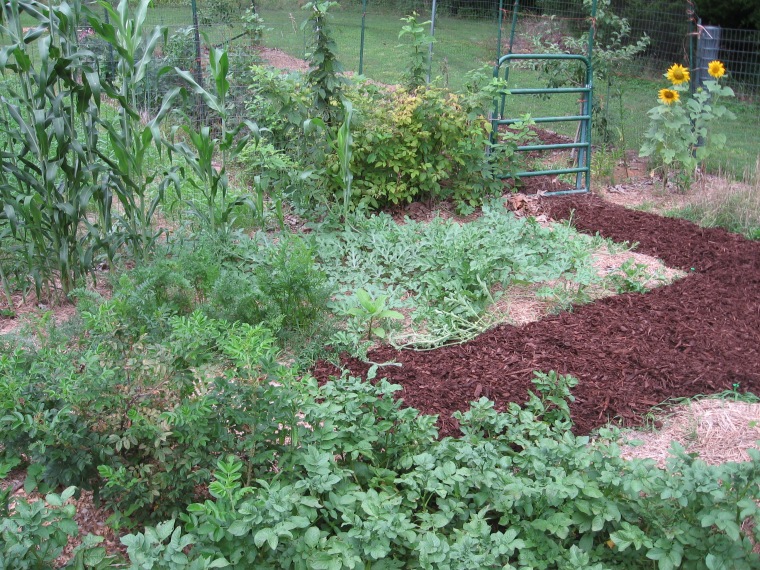“There are bugs in my garden!” is usually a sentence spoken with alarm by most gardeners. But what if it didn’t have to be that way? Sure about 1% percent of the invertebrates in our yards are trouble-makers, munching on our tomatoes or putting holes in our hostas, but the other 99% are innocent of such crimes and might even be helping you. These creatures lead fascinating lives. They pollinate our flowers, eat our pests, convert our compost to fertilizer, or munch fungus off our grape leaves. However, it’s one thing to appreciate all the good invertebrates do in our yards, it’s another to truly enjoy their company. With a little work, even the most bug-phobic gardener can learn to see this multitude of garden denizens with fascination, not revulsion.
- Start with the pretty critters

No one expects you to go from avowed bug-hater to waxing poetic over millipedes overnight. Start by viewing “training-wheel invertebrates”, creatures that are easy to see and generally thought of as pretty. Plant a butterfly garden, and admire its visitors. Catch fireflies. Look for ladybugs eating aphids off of your apple tree. The more time you spend making positive associations with invertebrates, the more comfortable you will feel around them. Once you get comfortable with these creatures, look for similarities with other garden inhabitants. For example, once you get used to butterflies and ladybugs, look for tiny hover flies visiting your flowers too, or watch their offspring eat aphids alongside your ladybugs.
- Look close for elegant details

Part of the transformation of feeling comfortable around creepy-crawlies, is learning how to see them in a way that makes them less, well, creepy. One of the best ways to do that is to learn to admire elegant features of each creature’s body design. The use of a magnifying glass, loop, or camera macro lens is helpful in this endeavor. A close look at the wings of a tiny leafhopper can reveal patterns that are as vibrant as any butterfly’s. Some insects have amazing antennae that look like feathers or birds wings or ancient spear heads. You can also admire the interesting signs of invertebrates’ passing. If spiders make you jump, you can still admire dew drops on a well-constructed web. Maybe worms are a bit slimy for you to enjoy handling them, but you can admire the lovely texture they create in your garden soil.
- Make visual connections

If a creature doesn’t at first wow you with its good looks, then try to make visual connections in a more out-of-the box manner. Maybe a Sminthuridid springtail looks like a character from an old Super Mario game, or a beetle pupa reminds you of a statue of a meditating Buddha, or a caterpillar reminds you of a baby dragon. Once you get in the habit of making these visual connections, invertebrates not only seem more familiar, but can become amusing or wondrous to behold.
- Watch for endearing behaviors

It’s easier to relate to invertebrate animals if they remind us of ourselves. A beetle daintily grooming herself might remind us of a friend getting ready for a night on the town. A male carpenter bee hovering to impress females might remind us of a cocky teenager strutting around to impress the ladies. The cooperative behavior of ants can make us think of the cooperative behavior of humans. (Lest any of my colleagues criticize me for encouraging “anthropomorphizing,” I say keep your sense of detachment for your research, and have fun in your own backyard!) Some behaviors, while not directly relatable to human behavior can also be delightful. Stop and watch pollinators industriously at work sipping nectar, admire the slow, inquisitive swaying of a snail’s eye-stalks, or be amused by the rhythmic dancing of beech aphids.
- Educate yourself

The more you understand the life history and behavior of the invertebrates in your yard, the less alien they will become. Read books about invertebrates and the people who study them. Follow the social media feeds of invertebrate biologists. Visit invertebrate exhibits at your local museum or nature center. Take part in citizen science projects to track rare or ecologically important invertebrates. Help out with a bioblitz.
If you follow these steps, you will learn to replace fear of these critters with wonder at their amazing forms and biology. It will take some time to get there, but the reward is worth it: you will exponentially increase wildlife viewing opportunities in your garden and gain the ability to find joy in the tiniest places.





























